

NECROPHAGUS
Color, 1971, 87 mins. 23 secs.
Directed by "Michael Skaife" (Miguel Madrid)
Starring John Clark, Catherine Ellison, Bill Curran, María Paz Madrid, Victor Israel, Marisa Shiero, Julián Ugarte, Marisa Paredes, Eusebio Poncela
CAKE OF BLOOD
Color, 1971, 90 mins. 24 secs.
Directed by Francesc Bellmunt, Jaime Chávarri, Emilio Martínez Lázaro, José María Vallés
Starring Marisa Paredes, Eusebio Poncela, Julián Ugarte, Marta May, Ángel Carmona Ristol, Carlos Otero, Fernando Rubio, Luis Ciges, Romy, José Lifante
THE CROSS OF THE DEVIL
Color, 1974, 96 mins. 58 secs.
Directed by John Gilling
Starring Ramiro Oliveros, Carmen Sevilla, Adolfo Marsillach
NIGHT OF THE WALKING DEAD
Color, 1975, 88 mins. 13 secs.
Directed by León Klimovsky
Starring Emma Cohen, Carlos Ballestreros, Viky Lussón ,
Rafael Hernández , Barringo Jordan
Severin Films (Blu-ray) (US R0 HD) / WS (1.85:1 / 2.35:1) (16:9)
After paying tribute to the heyday of '60s and '70s 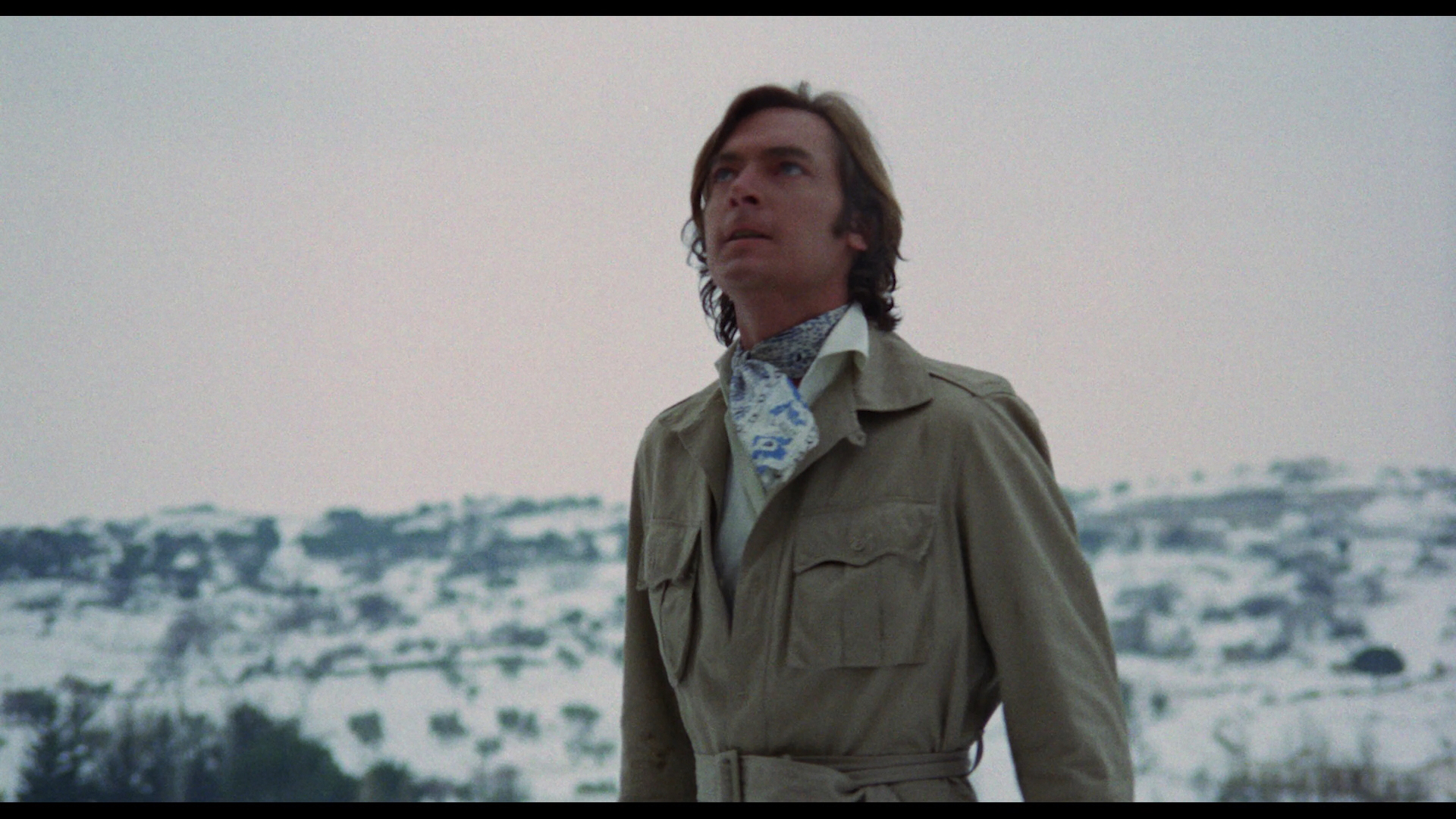 Italian Gothic horror with its first two Danza Macabra Blu-ray sets, Severin
Italian Gothic horror with its first two Danza Macabra Blu-ray sets, Severin 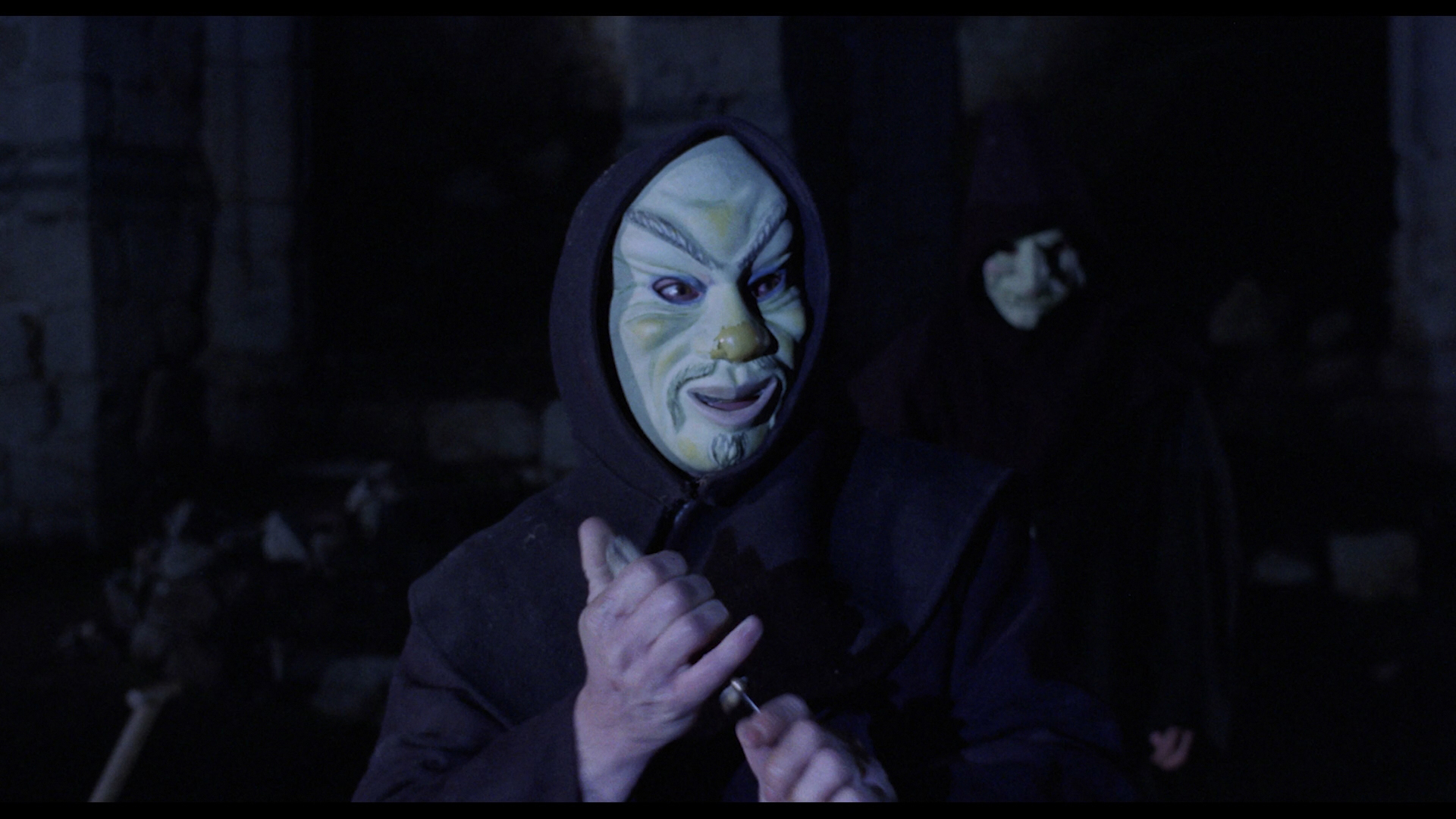 Films shifted gears in 2024 with Danza Macabra Volume Three: The Spanish Gothic Collection. Here you get a quartet of '70s Spanish chillers, two of which have been fairly easy to find in the U.S. but always in woefully substandard editions. The other two are worthwhile rarities previously confined to the depths of the gray market in unwatchable dupes, here restored in a condition better than anyone could have possibly imagined.
Films shifted gears in 2024 with Danza Macabra Volume Three: The Spanish Gothic Collection. Here you get a quartet of '70s Spanish chillers, two of which have been fairly easy to find in the U.S. but always in woefully substandard editions. The other two are worthwhile rarities previously confined to the depths of the gray market in unwatchable dupes, here restored in a condition better than anyone could have possibly imagined.
First up is the very low-key period 1971 chiller Necrophagus, better known to VHS and DVD hounds from its Super Video tape and Image Entertainment EuroShock disc release as Graveyard of Horror. Also shown as The Butcher of Binbrook, it takes place in some temporal netherworld where Michael (Curran) returns to his ancestral home where his wife died under mysterious childbirth circumstances and his older brother, the Sir Robert Sherrington, seems to be missing. In the process he encounters masked 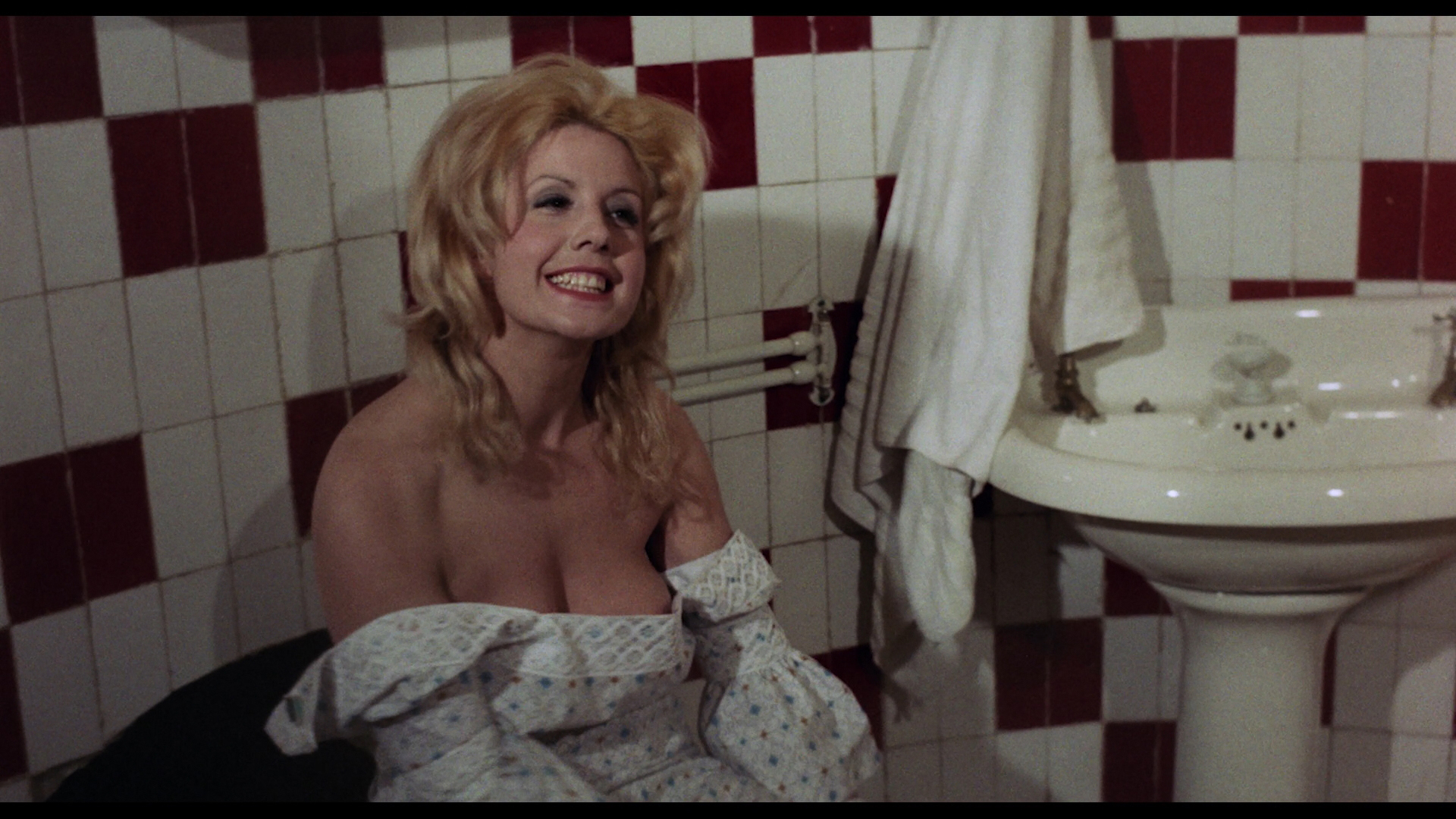 assailants in the adjoining graveyard, gets manipulated by all of his family members, and
assailants in the adjoining graveyard, gets manipulated by all of his family members, and  goes AWOL for a while to make way for an investigating cop (Horror Express' Israel), all before the big dark secret is finally revealed. And you'll never believe it, even if the DVD cover and most of the international poster art give it away.
goes AWOL for a while to make way for an investigating cop (Horror Express' Israel), all before the big dark secret is finally revealed. And you'll never believe it, even if the DVD cover and most of the international poster art give it away.
Low on coherence but high on atmosphere, Necrophagus feels like a throwback to the moody, genteel, and very odd creature features of the '50s (especially The Maze and The Fly, for reasons that should be obvious at the end), and it seems tailor made to be run at any hour on TV to fill time for viewers who are wandering in and out of the room. This was the first feature for writer-director Miguel Madrid (under the name Michael Skaife, and he has a cameo role as well), which was followed by the very different and effective The Killer of Dolls and the obscure sex comedy Bacanal en directo. The fact that this has always lurked murky and miserable on home video hasn't really done this one any favors, and the Blu-ray goes a long way to making it more of a visual treat (if not necessarily more of a narrative one!) as it's sourced from a 4K scan of what's touted as the recently discovered negative. 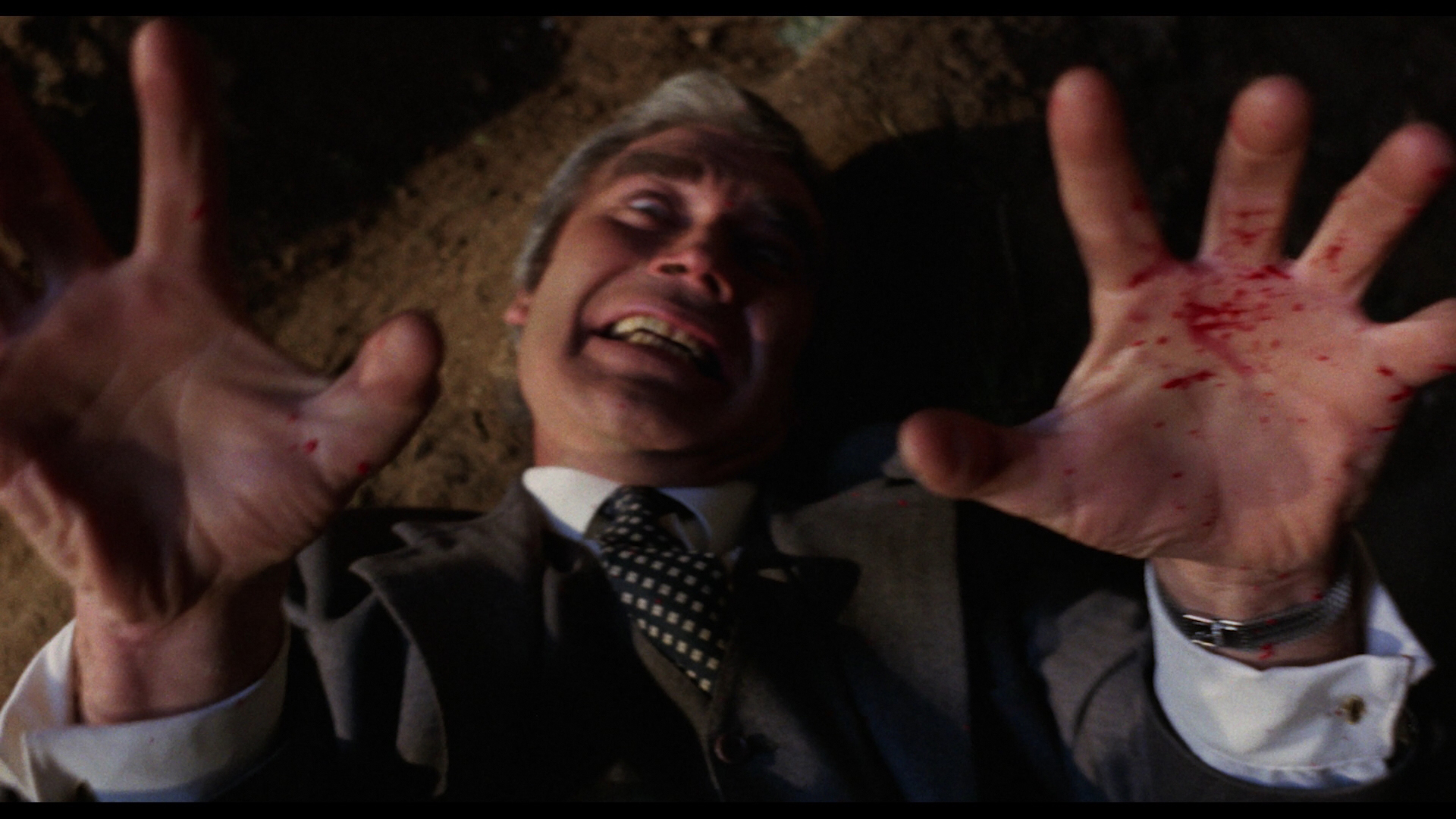
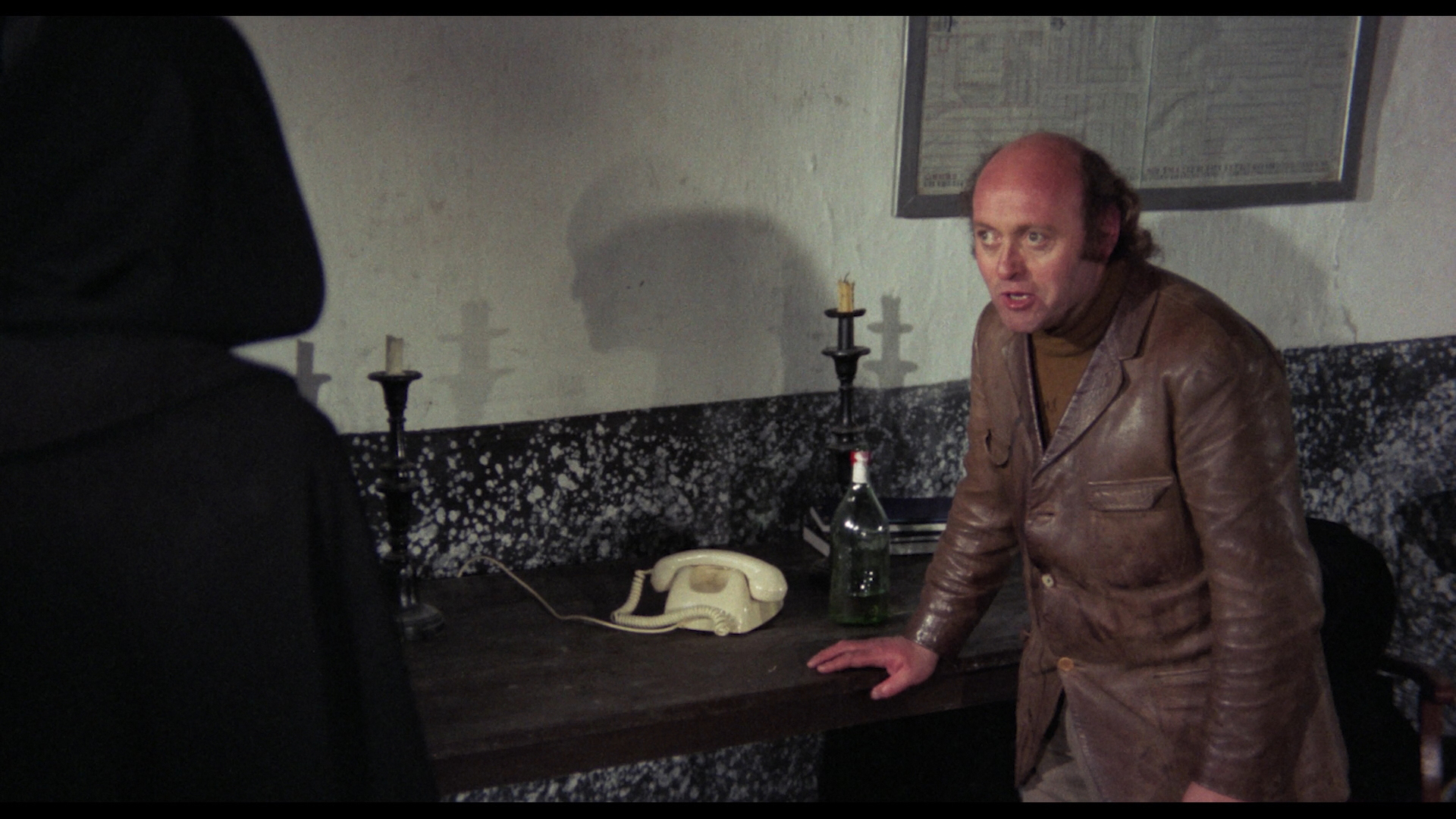 At last you can clearly see what's going on in those dark graveyard scenes, which is especially important during the finale. The DTS-HD MA 2.0 mono English and Spanish tracks both sound great; it's a draw which one is preferable as it was shot in a combination of the two languages and dubbed in post-production either way. The Spanish one feels more elegant though, and optional English (SDH and translated) subtitles are provided. Either way you can enjoy one of the film's strongest assets, the eccentric and clever score by Alfonso Santisteban (which incredibly ended up getting a CD release paired with The Killer of Dolls). A new commentary by The Nasty Pasty Podcast's Andy Marshall-Roberts does a skillful job of covering the pertinent facts of the actors and crew while also pointing out the relevant literary nods to authors like Edgar Allan Poe along the way. In "Something You've Never Seen" (8m6s), Ángel Sala, The Sitges Film Festival's Head Of Programming, chats about the film's divisive nature, the attempts to pass this off as an Anglo production a la Hammer or Amicus, Madrid's career, and the state of Spanish horror at the time. Then in "The First Horror Film Festival in the World" (11m2s), Maria Pilar Rafáles, daughter Of Sitges Film Festival Founder Antonio Rafáles, recalls the creation of the vital genre celebration in 1968 and the launch of its competitive incarnation in 1971 with participation from a wide range of countries and journalists. Finally you get two trailers, as The Butcher of Binbrook (with the narrator still calling it Necrophagus) and Graveyard of Horror.
At last you can clearly see what's going on in those dark graveyard scenes, which is especially important during the finale. The DTS-HD MA 2.0 mono English and Spanish tracks both sound great; it's a draw which one is preferable as it was shot in a combination of the two languages and dubbed in post-production either way. The Spanish one feels more elegant though, and optional English (SDH and translated) subtitles are provided. Either way you can enjoy one of the film's strongest assets, the eccentric and clever score by Alfonso Santisteban (which incredibly ended up getting a CD release paired with The Killer of Dolls). A new commentary by The Nasty Pasty Podcast's Andy Marshall-Roberts does a skillful job of covering the pertinent facts of the actors and crew while also pointing out the relevant literary nods to authors like Edgar Allan Poe along the way. In "Something You've Never Seen" (8m6s), Ángel Sala, The Sitges Film Festival's Head Of Programming, chats about the film's divisive nature, the attempts to pass this off as an Anglo production a la Hammer or Amicus, Madrid's career, and the state of Spanish horror at the time. Then in "The First Horror Film Festival in the World" (11m2s), Maria Pilar Rafáles, daughter Of Sitges Film Festival Founder Antonio Rafáles, recalls the creation of the vital genre celebration in 1968 and the launch of its competitive incarnation in 1971 with participation from a wide range of countries and journalists. Finally you get two trailers, as The Butcher of Binbrook (with the narrator still calling it Necrophagus) and Graveyard of Horror.
Next 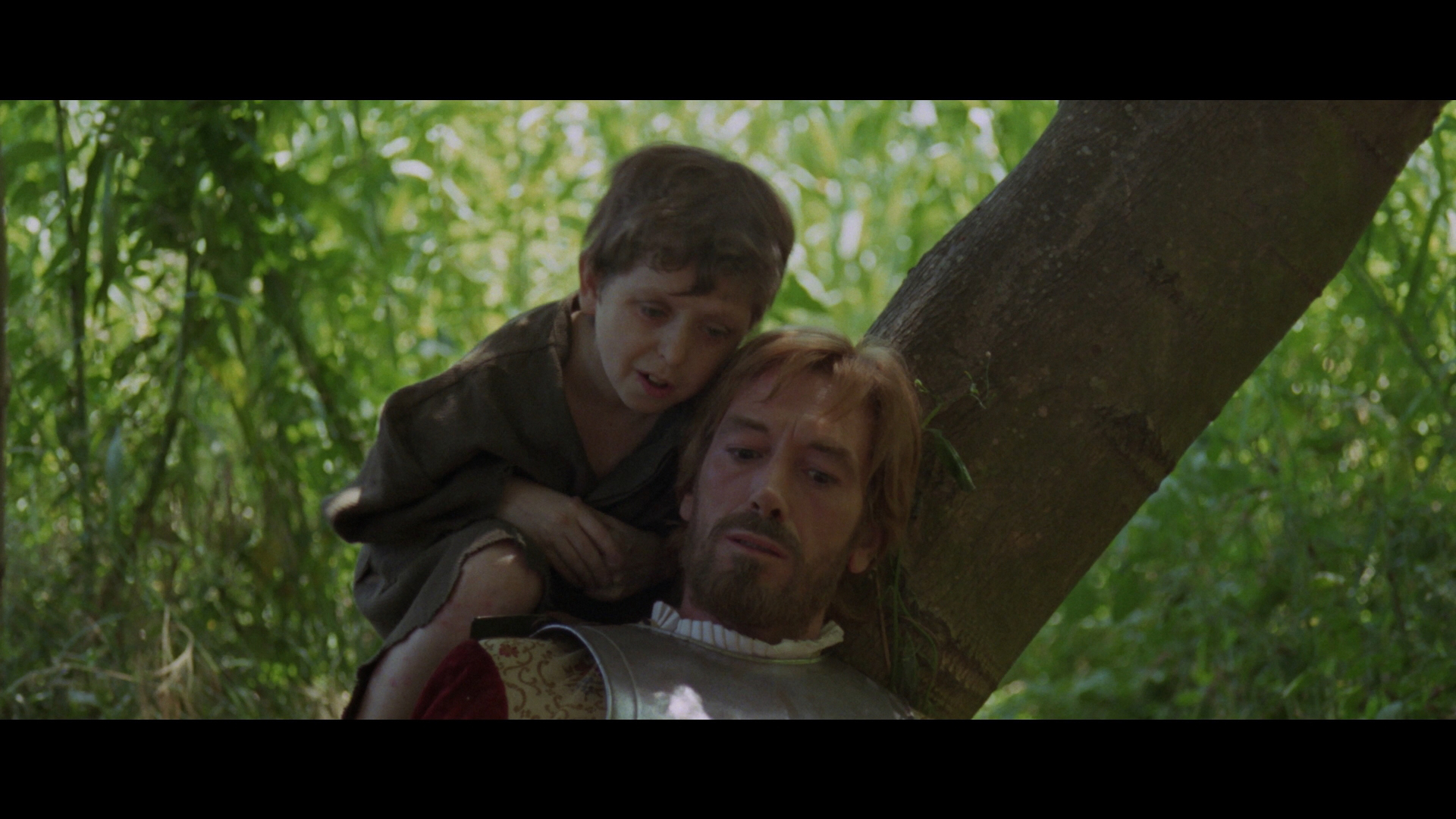 up is the least seen title in the set by a fair margin, 171's horror
up is the least seen title in the set by a fair margin, 171's horror 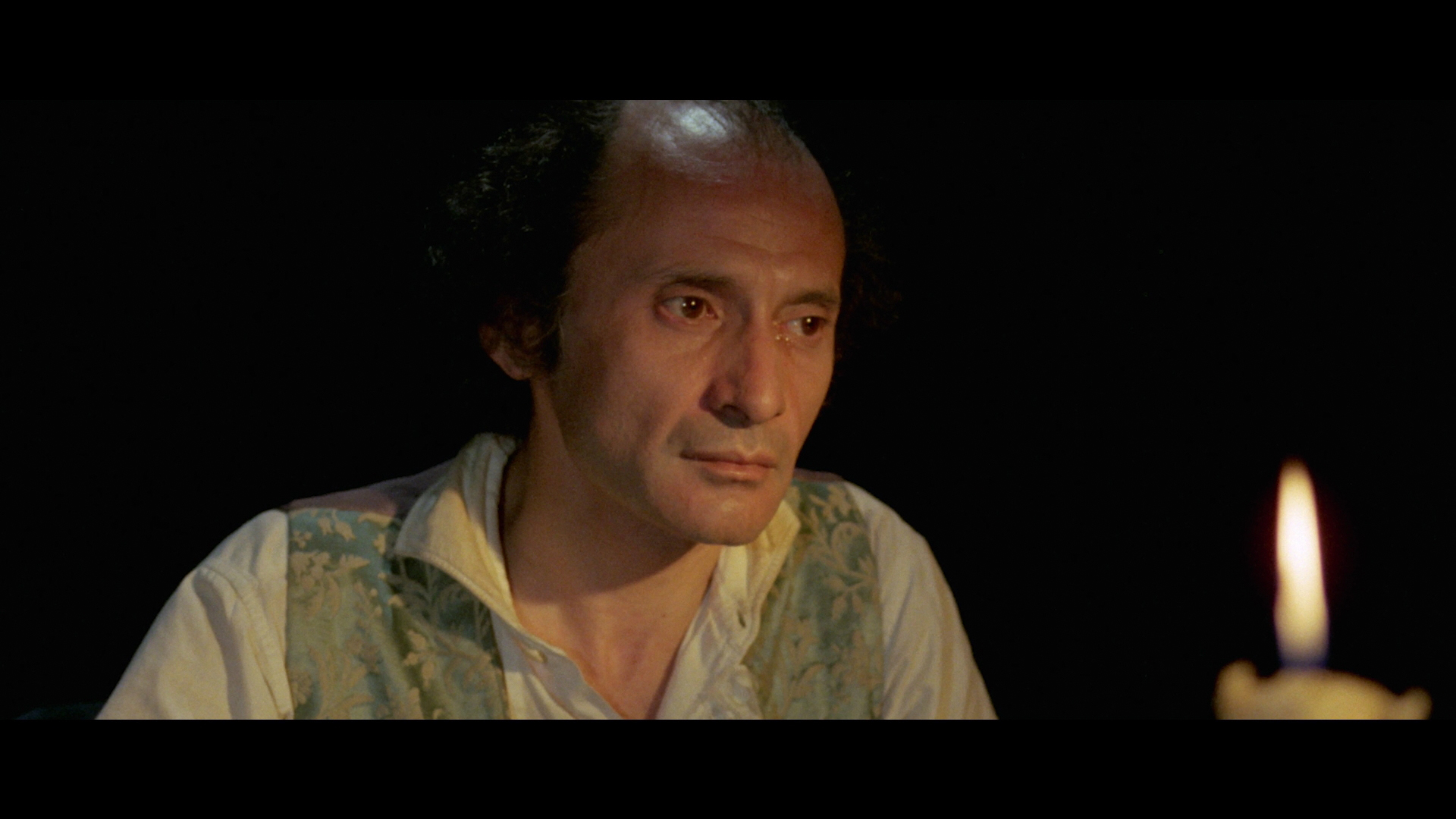 anthology Cake of Blood (Pastel de sangre). Here you get a quartet of stories spanning different time periods, all beautifully shot in scope by separate directors for each. The odd title presumably implies that each story is a different "slice" from this macabre confection, starting with the sparse and haunting "Tarot" starring Julián Ugarte (the creepy cult leader from All the Colors of the Dark). Here he plays a medieval knight on horseback embarking on a death-haunted journey that leads him through a forest and some oddball characters, eventually reaching a beautiful woman who represents his dark fate. The artiest and most abstract of the tales, this one looks great and has that eerie doomed romanticism of films like Leonor. This would be the only feature credit for director José María Vallés, who otherwise worked in arty short films. Next up is the most surprising story of the bunch, "Victor Frankenstein," a high unorthodox take on the Mary Shelley classic by Emilio Martínez-Lázaro that also serves as an early teaming of two Pedro Almodóvar staples, Marisa Paredes (All About My Mother) and Eusebio Poncela (Law of Desire), the latter in his film debut just before Cannibal Man, The House Without Frontiers, and The Killer Is One of Thirteen. Here the story gets compressed and inverted as Victor Frankenstein (Ristol) engineers a reanimated creature (Poncela)
anthology Cake of Blood (Pastel de sangre). Here you get a quartet of stories spanning different time periods, all beautifully shot in scope by separate directors for each. The odd title presumably implies that each story is a different "slice" from this macabre confection, starting with the sparse and haunting "Tarot" starring Julián Ugarte (the creepy cult leader from All the Colors of the Dark). Here he plays a medieval knight on horseback embarking on a death-haunted journey that leads him through a forest and some oddball characters, eventually reaching a beautiful woman who represents his dark fate. The artiest and most abstract of the tales, this one looks great and has that eerie doomed romanticism of films like Leonor. This would be the only feature credit for director José María Vallés, who otherwise worked in arty short films. Next up is the most surprising story of the bunch, "Victor Frankenstein," a high unorthodox take on the Mary Shelley classic by Emilio Martínez-Lázaro that also serves as an early teaming of two Pedro Almodóvar staples, Marisa Paredes (All About My Mother) and Eusebio Poncela (Law of Desire), the latter in his film debut just before Cannibal Man, The House Without Frontiers, and The Killer Is One of Thirteen. Here the story gets compressed and inverted as Victor Frankenstein (Ristol) engineers a reanimated creature (Poncela)  who's a young, good-looking man with no sense of basic
who's a young, good-looking man with no sense of basic 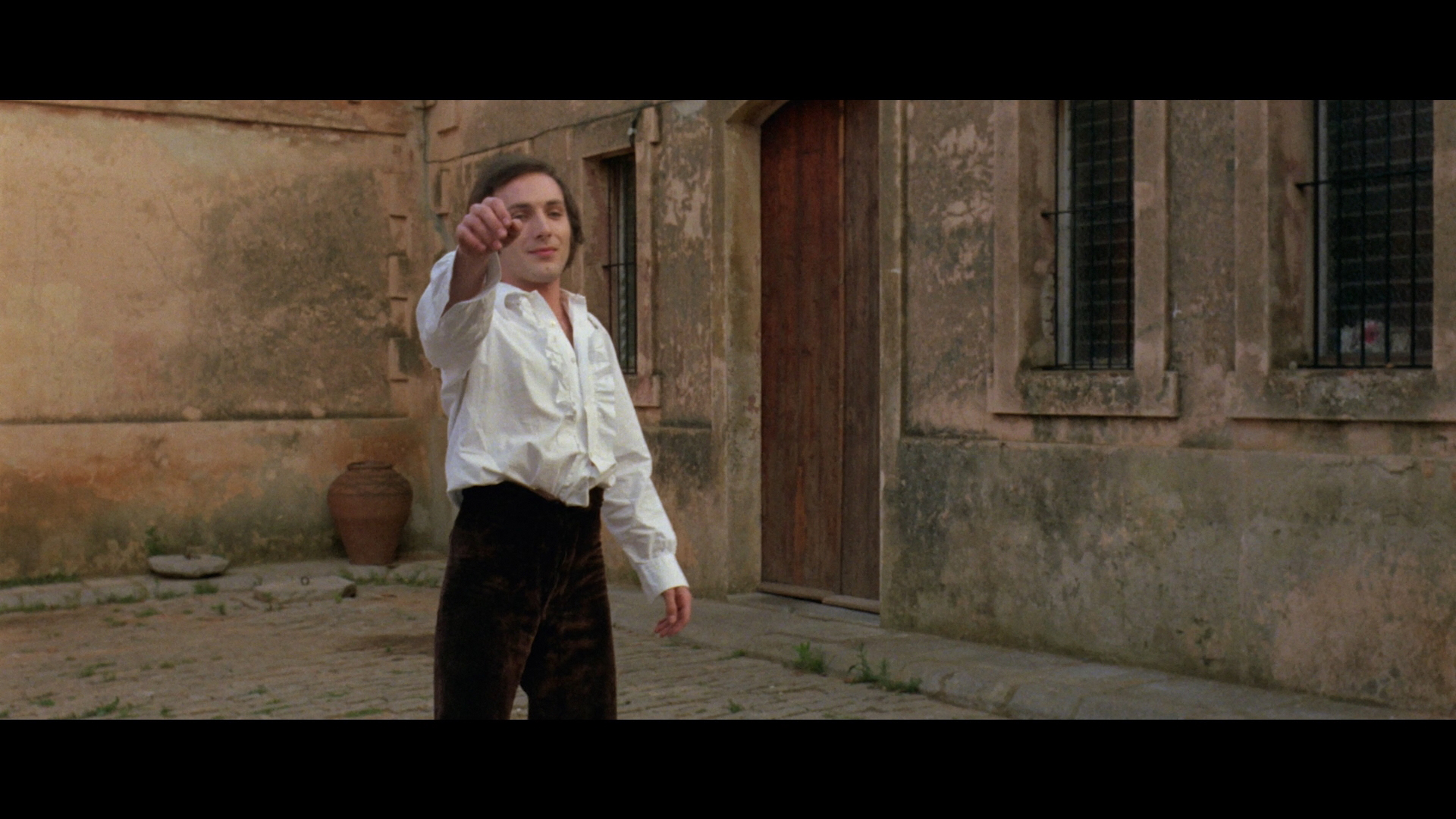 morality or social behavior. That proves to be a major hazard to anyone in the vicinity including Victor's bride, Elizabeth (Paredes). Then in "Terror Among Christians" by Francesc Bellmunt, takes place in Rome during the superstition-plagued reign of Emperor Nero as the new religion of Christianity is being aggressively persecuted, which has a bearing on two men, Cándido (Otero) and Marco (Rubio), embarking on a forest journey that will lead them to a supernatural destination. This one really ladles on the Gothic imagery with a shovel, including spooky caves and the always striking imagery of dead bodies dangling in trees. Finally in Jaime Chávarri's "The Dance or Emotional Survivals," a peeping tom vagrant (Ciges) gets talked by another, wealthier man (Lifante) into breaking into and robbing the home of an isolated woman (Romy) who mostly sits around smoking all day. However, all is not as it seems, to put it mildly. Stylish and clever, this is the one modern-day story and a fine way to close out this unorthodox omnibus.
morality or social behavior. That proves to be a major hazard to anyone in the vicinity including Victor's bride, Elizabeth (Paredes). Then in "Terror Among Christians" by Francesc Bellmunt, takes place in Rome during the superstition-plagued reign of Emperor Nero as the new religion of Christianity is being aggressively persecuted, which has a bearing on two men, Cándido (Otero) and Marco (Rubio), embarking on a forest journey that will lead them to a supernatural destination. This one really ladles on the Gothic imagery with a shovel, including spooky caves and the always striking imagery of dead bodies dangling in trees. Finally in Jaime Chávarri's "The Dance or Emotional Survivals," a peeping tom vagrant (Ciges) gets talked by another, wealthier man (Lifante) into breaking into and robbing the home of an isolated woman (Romy) who mostly sits around smoking all day. However, all is not as it seems, to put it mildly. Stylish and clever, this is the one modern-day story and a fine way to close out this unorthodox omnibus.
Never given an official home video release and virtually impossible to see for decades outside of an incredibly dupey bootleg, Cake of Blood looks superb here with a fresh 4K scan from the camera negative. This is the sole scope entry in the set, and it's a real visual treat from start to  finish with each director giving it the look and vibe of a '70s art film. The DTS-HD MA 2.0 Spanish
finish with each director giving it the look and vibe of a '70s art film. The DTS-HD MA 2.0 Spanish 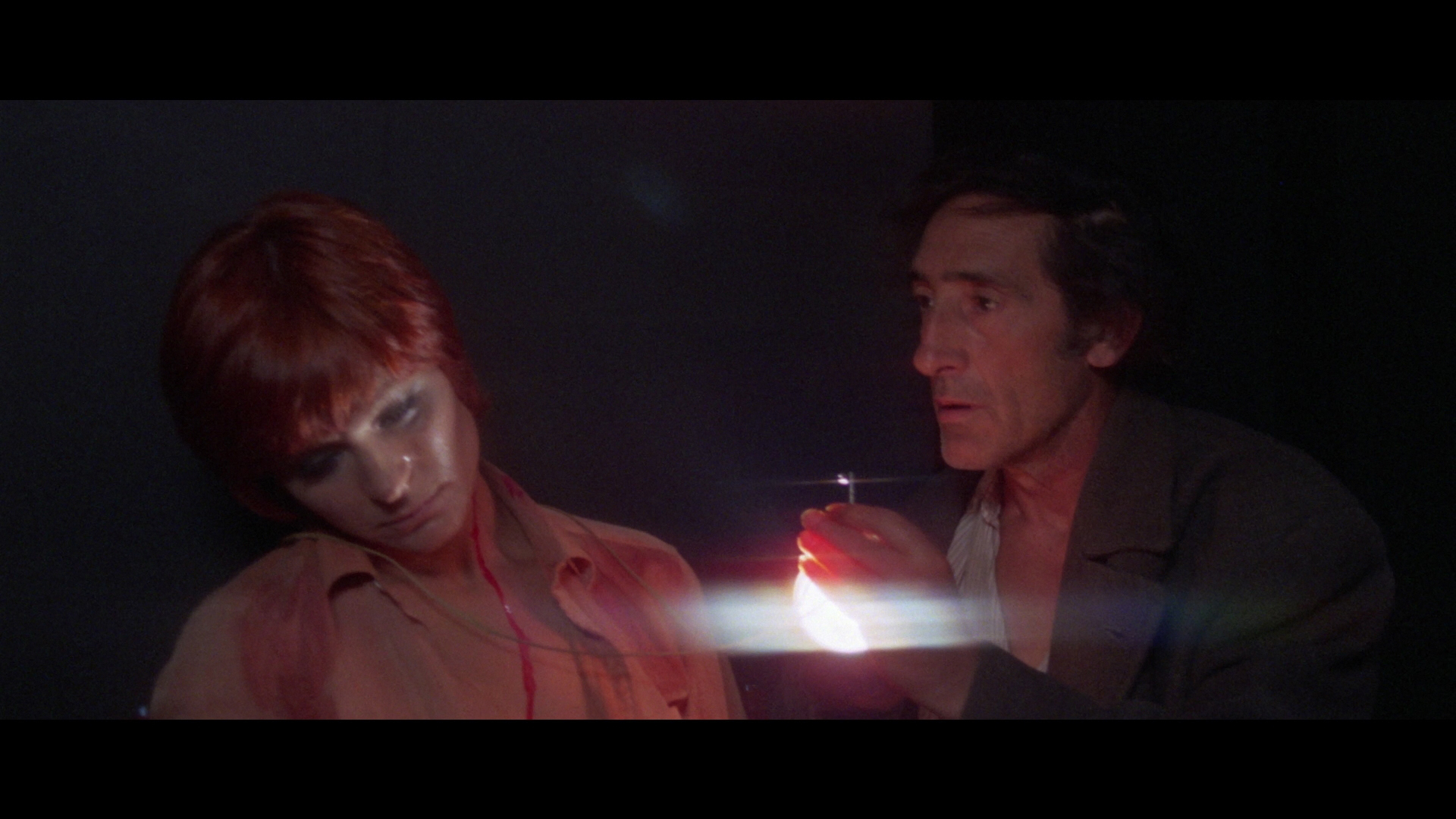 mono track is also in perfect shape and features optional English subtitles. An audio Commentary by the NaschyCast's Rod Barnett and Norman J. Warren: Gentleman of Terror co-author Adrian Smith covers all the bases well with notes on the cast and directors, the thematic elements running through the stories, the challenges of making a genre film under a fascist dictatorship at the time, and links to other Spanish horror productions around that time. In "My Generation" (4m31s), Paredes speaks briefly about her early career starting off in her late teens, her acclaim doing TV productions in the late '60s, her gratitude for never having to audition, and her background at the time she was hired for this film. In "I Just Wanted to Have Fun" (21m6s), Jaime Chávarri chats about his work in 20-odd films and his turn to doing TV, his "amateur" perception of himself as both an underground and commercial filmmaker, and the artistic community in Barcelona. In "To Whoever Wants to Watch" (11m39s), Lifante also echoes the lack of traditional casting and audition processes at the time as well as the directorial process that tended to be very loose and stimulating. Finally in "An Arthouse UFO" (11ms), Sala returns to shed additional light on the four directors, their futures after this film, the political concerns of the time, and the oddity of mounting an anthology art genre film within Spain.
mono track is also in perfect shape and features optional English subtitles. An audio Commentary by the NaschyCast's Rod Barnett and Norman J. Warren: Gentleman of Terror co-author Adrian Smith covers all the bases well with notes on the cast and directors, the thematic elements running through the stories, the challenges of making a genre film under a fascist dictatorship at the time, and links to other Spanish horror productions around that time. In "My Generation" (4m31s), Paredes speaks briefly about her early career starting off in her late teens, her acclaim doing TV productions in the late '60s, her gratitude for never having to audition, and her background at the time she was hired for this film. In "I Just Wanted to Have Fun" (21m6s), Jaime Chávarri chats about his work in 20-odd films and his turn to doing TV, his "amateur" perception of himself as both an underground and commercial filmmaker, and the artistic community in Barcelona. In "To Whoever Wants to Watch" (11m39s), Lifante also echoes the lack of traditional casting and audition processes at the time as well as the directorial process that tended to be very loose and stimulating. Finally in "An Arthouse UFO" (11ms), Sala returns to shed additional light on the four directors, their futures after this film, the political concerns of the time, and the oddity of mounting an anthology art genre film within Spain.
 Mentioned in horror
Mentioned in horror 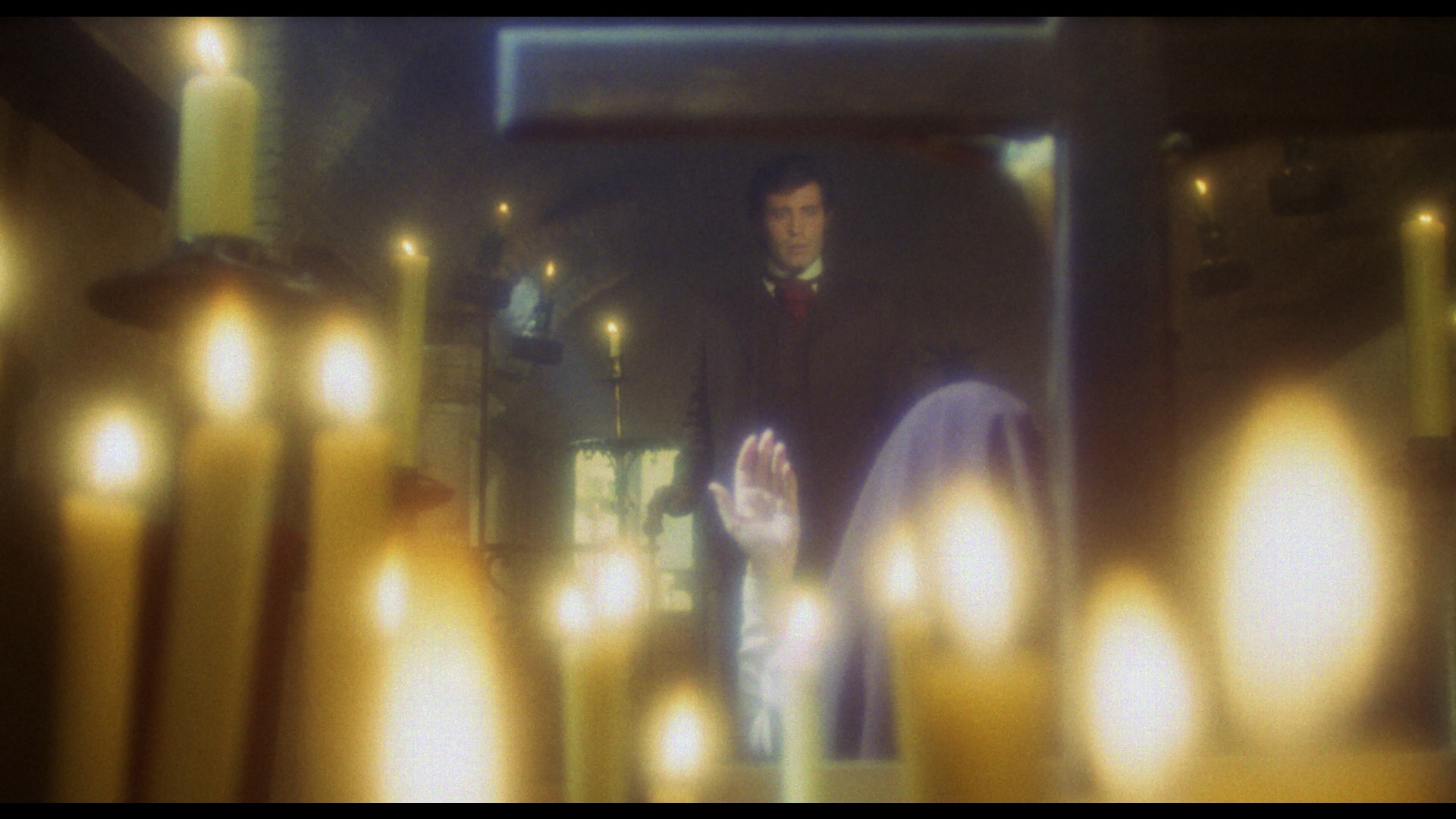 publications far more often than it's actually been seen, disc three's Cross of the Devil is a fascinating entry for multiple reasons. First of all, this was the final and highly unusual feature for director John Gilling, best known for his small but notable output for Hammer (The Reptile, The Plague of the Zombies, The Shadow of the Cat, etc.) and the excellent The Flesh and the Fiends. Having retired in 1967 and relocated to Spain, he was an unexpected choice to tackle this film which began as a passion project for Paul Naschy, who was very vocal about how he was screwed over during the process of getting it made. Inspired by and even name checking the work of Spanish author Gustavo Adolfo Bécquer, this film is usually grouped into the odd offshoot of unofficial Blind Dead films dealing with the Knights Templar, along with Mansion of the Living Dead, Graveyard of the Dead, and Curse of the Blind Dead. The Templars have very little screen time here, mostly popping up in the opening and the climax as part of a mystery that engulfs Alfred Dawson (Oliveros), a drug-addicted writer in London having intense visions of skull-faced Templars tormenting a young woman. His sister Justine (The Witches Mountain's Randall) writes to him asking for help, but when he arrives in her Spanish
publications far more often than it's actually been seen, disc three's Cross of the Devil is a fascinating entry for multiple reasons. First of all, this was the final and highly unusual feature for director John Gilling, best known for his small but notable output for Hammer (The Reptile, The Plague of the Zombies, The Shadow of the Cat, etc.) and the excellent The Flesh and the Fiends. Having retired in 1967 and relocated to Spain, he was an unexpected choice to tackle this film which began as a passion project for Paul Naschy, who was very vocal about how he was screwed over during the process of getting it made. Inspired by and even name checking the work of Spanish author Gustavo Adolfo Bécquer, this film is usually grouped into the odd offshoot of unofficial Blind Dead films dealing with the Knights Templar, along with Mansion of the Living Dead, Graveyard of the Dead, and Curse of the Blind Dead. The Templars have very little screen time here, mostly popping up in the opening and the climax as part of a mystery that engulfs Alfred Dawson (Oliveros), a drug-addicted writer in London having intense visions of skull-faced Templars tormenting a young woman. His sister Justine (The Witches Mountain's Randall) writes to him asking for help, but when he arrives in her Spanish  village, it appears she's been murdered at an occult spot known as the Devil's Cross. The full story doesn't seem to
village, it appears she's been murdered at an occult spot known as the Devil's Cross. The full story doesn't seem to  be forthcoming, especially when the man accused of the crime commits suicide (or does he?), which leads to a murder mystery with a supernatural surprise.
be forthcoming, especially when the man accused of the crime commits suicide (or does he?), which leads to a murder mystery with a supernatural surprise.
It isn't difficult to see why this film has languished in obscurity for so long or why it was barely released, never even playing theatrically or getting a VHS release outside of Spain. By 1975 standards, it's decidedly out of step with the mindset of moviegoers who were being thrilled by titles like Jaws, Deep Red, Shivers, or the final Blind Dead film, Night of the Seagulls. This is a much more restrained period piece focusing on atmosphere and psychological ambiguity, but if you're a Spanish horror junkie or simply willing to take this on its own terms, there's an effective creepiness here that pays off in a delirious and haunting final ten minutes. On top of that you get a solid cast including Emma Cohen (The Other Side of the Mirror), Eduaro Fajardo (Lisa and the Devil), and Adolfo Marsillach, father of Opera's Cristina and The Devil's Honey's Blanca. The Severin release makes for a great way to experience this one as well, looking vastly superior to the terrible dupes out there and bringing out the most of the delicate, often filtered photography that gives this the look of an antique photograph. The Spanish DTS-HD MA 2.0 mono track sounds excellent and features optional English subtitles. The reliable team of Kim Newman and Barry Forshaw here are back with another informative commentary covering the Naschy controversy, the Gothic horror literary tropes, the ambiguity of the narrative, and the mingling of different elements including zombies and ghosts. In "Fascinated by Bécquer" (11m26s), screenwriter Juan José Porto talks about his own background in journalism, his interest in the author of the source material, his working process with Gilling, and of course, his friendship with Naschy that went sour because of this project. Sala returns for "The Real Templar Knights Movie" (8m55s), analyzing how this film comes during a shift in Spanish horror and makes for a unique attempt to capture the Poe-style flavor of Bécquer's writing on film. Finally in "Fantasy and Imagination: The Legacy Of Gustavo Adolfo Bécquer" (12m53s), Xavier Aldana Reyes, author Of Spanish Gothic: National Identity, Collaboration And Cultural Adaptation, looks specifically at the author's place in the Spanish literary and genre heritage even if his name isn't given much international recognition. 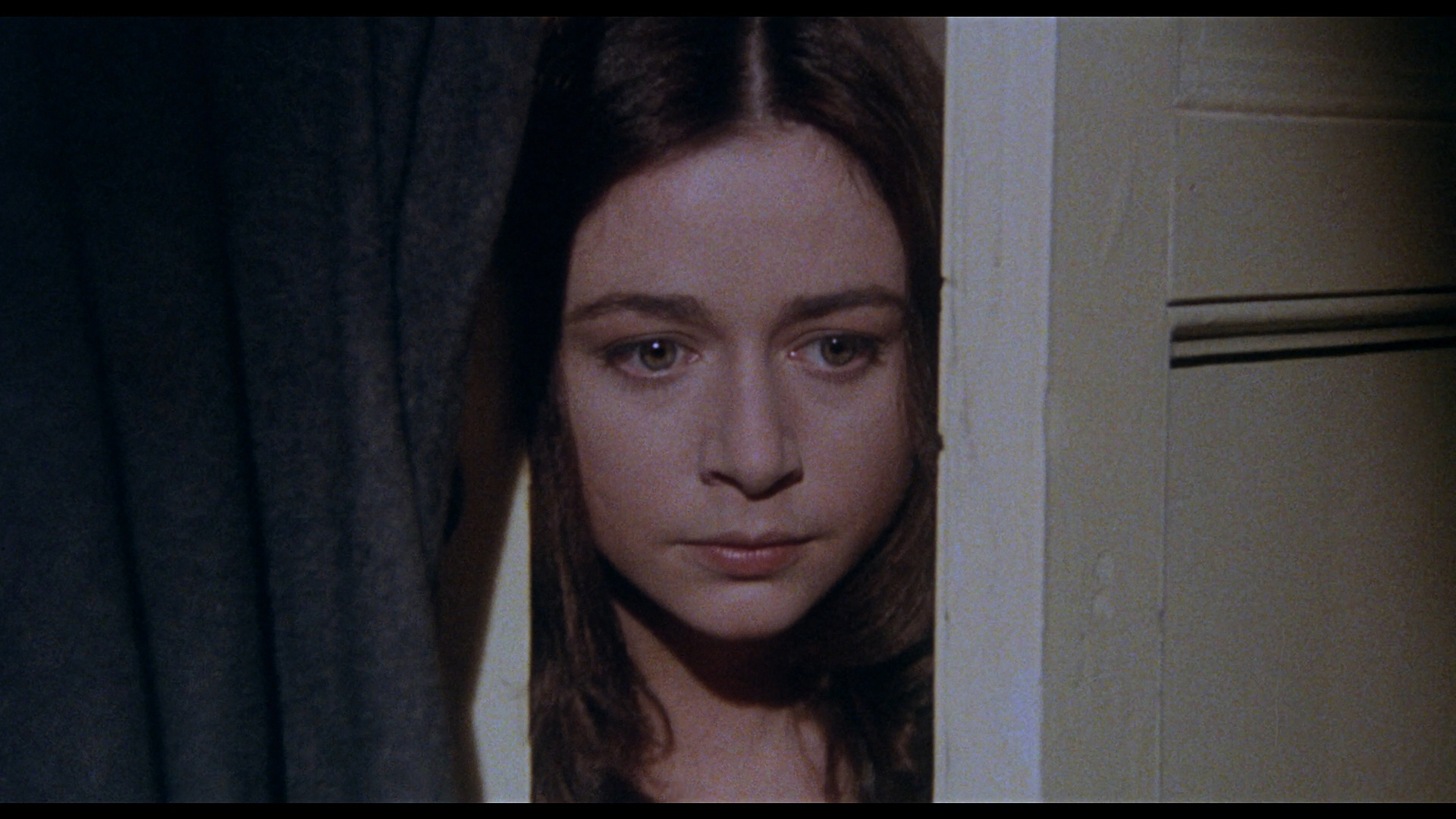
 Finally on disc four we get to Night of the Walking Dead, the ridiculous U.S. title imposed on the fascinating El extraño amor de los vampiros (or Strange Love of the Vampires). Not to be confused with Castle of the Walking Dead (a.k.a. Torture Chamber of Dr. Sadism), this is most definitely a vampire film as opposed to a zombie one and also stands as a fine entry in the bloodsucker cycle by director León Klimovsky (The Dracula Saga, The Vampires Night Orgy, The Werewolf Versus the Vampire Woman). Cohen returns here and gets starring honors as the ailing Catherine, who's feeling especially despondent after losing her sister, being diagnosed with a terminal form of tuberculosis, catching her beloved Jean (Jordan) trysting in the barn with another woman, and being left to her own devices so her parents can go off on vacation. All of this makes her a prime attraction for the mysterious Count Rudolph de Winberg (Ballesteros), who has vampirized her sister and is now keen on putting the bite on Catherine in her bedroom. Intrigued, our protagonist decides to accept an invitation to the Count's nearby castle where he throws swanky bloodletting masquerade parties and professes his love for Catherine, with their contrasting views on mortality making them a highly unusual couple at risk from the monster-hunting locals.
Finally on disc four we get to Night of the Walking Dead, the ridiculous U.S. title imposed on the fascinating El extraño amor de los vampiros (or Strange Love of the Vampires). Not to be confused with Castle of the Walking Dead (a.k.a. Torture Chamber of Dr. Sadism), this is most definitely a vampire film as opposed to a zombie one and also stands as a fine entry in the bloodsucker cycle by director León Klimovsky (The Dracula Saga, The Vampires Night Orgy, The Werewolf Versus the Vampire Woman). Cohen returns here and gets starring honors as the ailing Catherine, who's feeling especially despondent after losing her sister, being diagnosed with a terminal form of tuberculosis, catching her beloved Jean (Jordan) trysting in the barn with another woman, and being left to her own devices so her parents can go off on vacation. All of this makes her a prime attraction for the mysterious Count Rudolph de Winberg (Ballesteros), who has vampirized her sister and is now keen on putting the bite on Catherine in her bedroom. Intrigued, our protagonist decides to accept an invitation to the Count's nearby castle where he throws swanky bloodletting masquerade parties and professes his love for Catherine, with their contrasting views on mortality making them a highly unusual couple at risk from the monster-hunting locals.
Though this one was fairly easy to track down on VHS and gray market copies over the years, it always looked terrible until the gorgeous Blu-ray restoration seen here. It's fairly strong stuff at times for a '75 Spanish horror film including splashes of gore and full frontal nudity, while the soundtrack is an amusing patchwork of familiar library tracks including main titles scored by the blasting KPM track "Hippy" by a very Morricone-influenced Alan Parker (also used prominently in the U.S. trailer and opener of Torso). It's a much easier film to appreciate here with its swooning romanticism baked into every detail of the clothing and production design, especially in the final half hour when things really kick into high gear. The film was shot in Spanish and 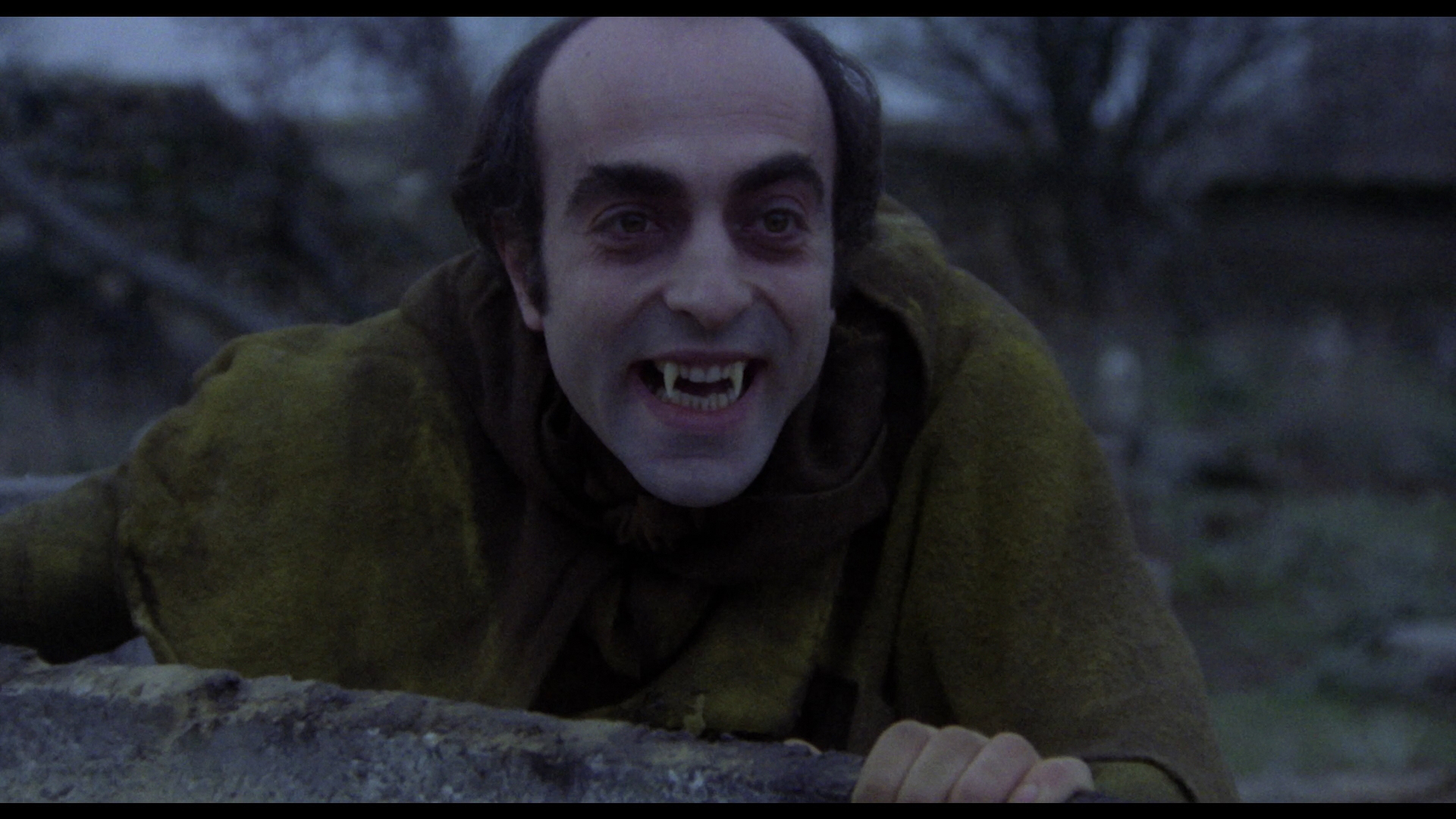 plays better that way between the two choices on the Blu-ray, though the English dub is here if
plays better that way between the two choices on the Blu-ray, though the English dub is here if 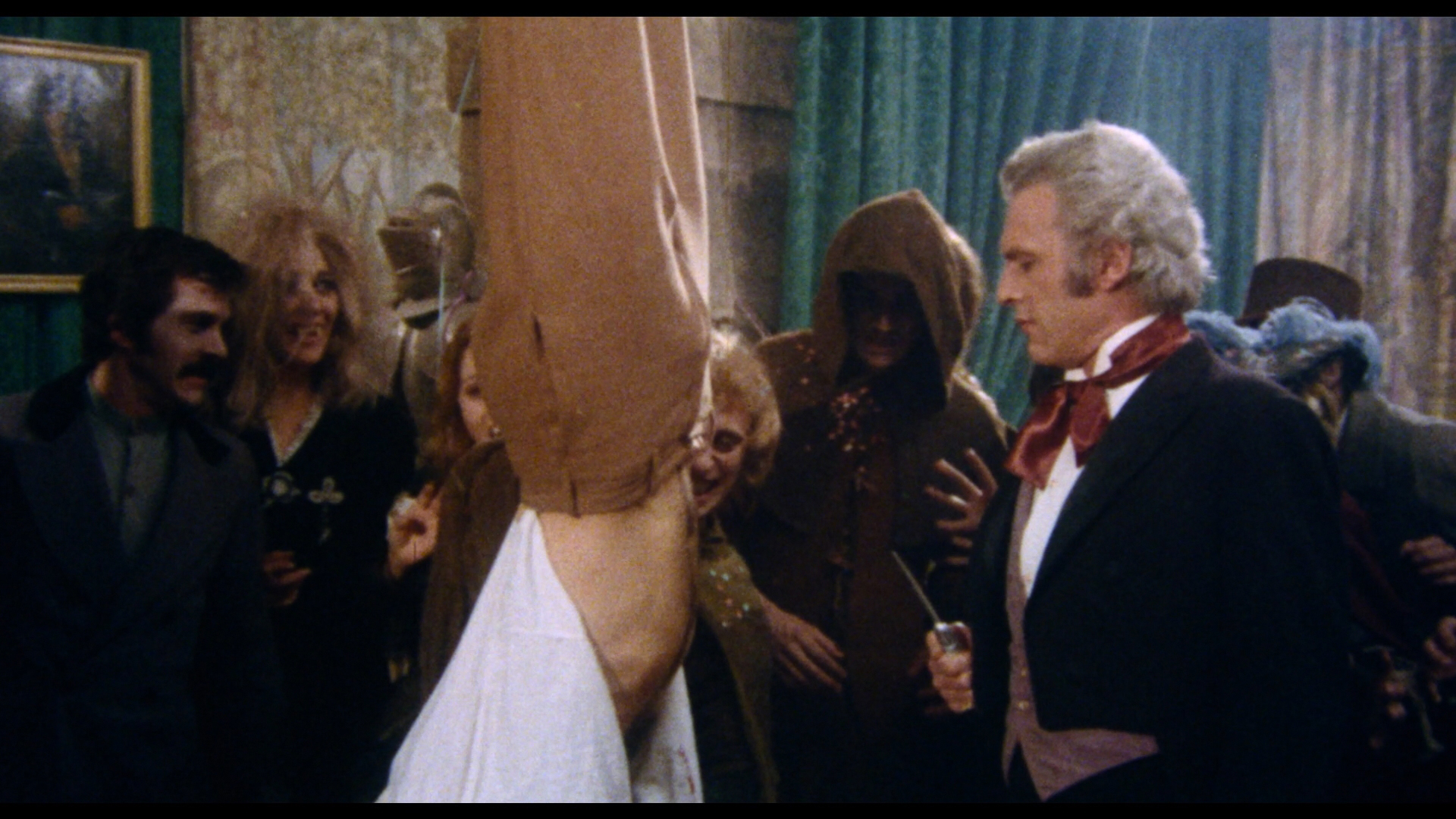 you feel so inclined. A new commentary by Kat Ellinger (who oversaw all of the Danza Macabra sets) continues her fascination with all things Gothic by contrasting the Spanish and Italian strains, exploring the more demented elements included here, and comparing the male versus female energy of these kinds of stories. Sala appears one last time for "A Deadly Invitation to Another Dimension" (10m3s), examining Klimovsky's treatment of the vampire mythos and how it compares to the Hammer films that were still casting a long shadow at the time. Porto turns up again for "Leo's Signature" (8m8s), recalling a pivotal encounter at Sitges that led to the concept of his film, his writing process here, and Klimovsky's working methods and artistic stamp. In "Dead Man Walking" (18m32s), Lifante returns (this time with a very noisy microphone) talking about his theater background and his approach to playing horror characters. Finally in "Spain's Cinematic Vampires" (24m39s), Xavier Aldana Reyes, author Of Spanish Gothic: National Identity, Collaboration And Cultural Adaptation, explores the rich and very unique history of vampirism during the '70s heyday spearheaded by Naschy and representing an exploration of taboo material and social commentary that pushed as hard as filmmakers could under the conditions of the period. Finally the disc closes with the Spanish title sequence, which is far more fun and stylish than the English one included on the main feature.
you feel so inclined. A new commentary by Kat Ellinger (who oversaw all of the Danza Macabra sets) continues her fascination with all things Gothic by contrasting the Spanish and Italian strains, exploring the more demented elements included here, and comparing the male versus female energy of these kinds of stories. Sala appears one last time for "A Deadly Invitation to Another Dimension" (10m3s), examining Klimovsky's treatment of the vampire mythos and how it compares to the Hammer films that were still casting a long shadow at the time. Porto turns up again for "Leo's Signature" (8m8s), recalling a pivotal encounter at Sitges that led to the concept of his film, his writing process here, and Klimovsky's working methods and artistic stamp. In "Dead Man Walking" (18m32s), Lifante returns (this time with a very noisy microphone) talking about his theater background and his approach to playing horror characters. Finally in "Spain's Cinematic Vampires" (24m39s), Xavier Aldana Reyes, author Of Spanish Gothic: National Identity, Collaboration And Cultural Adaptation, explores the rich and very unique history of vampirism during the '70s heyday spearheaded by Naschy and representing an exploration of taboo material and social commentary that pushed as hard as filmmakers could under the conditions of the period. Finally the disc closes with the Spanish title sequence, which is far more fun and stylish than the English one included on the main feature.
Reviewed on August 12, 2024



 Italian Gothic horror with its first two Danza Macabra Blu-ray sets, Severin
Italian Gothic horror with its first two Danza Macabra Blu-ray sets, Severin  Films shifted gears in 2024 with Danza Macabra Volume Three: The Spanish Gothic Collection. Here you get a quartet of '70s Spanish chillers, two of which have been fairly easy to find in the U.S. but always in woefully substandard editions. The other two are worthwhile rarities previously confined to the depths of the gray market in unwatchable dupes, here restored in a condition better than anyone could have possibly imagined.
Films shifted gears in 2024 with Danza Macabra Volume Three: The Spanish Gothic Collection. Here you get a quartet of '70s Spanish chillers, two of which have been fairly easy to find in the U.S. but always in woefully substandard editions. The other two are worthwhile rarities previously confined to the depths of the gray market in unwatchable dupes, here restored in a condition better than anyone could have possibly imagined.  assailants in the adjoining graveyard, gets manipulated by all of his family members, and
assailants in the adjoining graveyard, gets manipulated by all of his family members, and  goes AWOL for a while to make way for an investigating cop (Horror Express' Israel), all before the big dark secret is finally revealed. And you'll never believe it, even if the DVD cover and most of the international poster art give it away.
goes AWOL for a while to make way for an investigating cop (Horror Express' Israel), all before the big dark secret is finally revealed. And you'll never believe it, even if the DVD cover and most of the international poster art give it away.
 At last you can clearly see what's going on in those dark graveyard scenes, which is especially important during the finale. The DTS-HD MA 2.0 mono English and Spanish tracks both sound great; it's a draw which one is preferable as it was shot in a combination of the two languages and dubbed in post-production either way. The Spanish one feels more elegant though, and optional English (SDH and translated) subtitles are provided. Either way you can enjoy one of the film's strongest assets, the eccentric and clever score by Alfonso Santisteban (which incredibly ended up getting a CD release paired with The Killer of Dolls). A new commentary by The Nasty Pasty Podcast's Andy Marshall-Roberts does a skillful job of covering the pertinent facts of the actors and crew while also pointing out the relevant literary nods to authors like Edgar Allan Poe along the way. In "Something You've Never Seen" (8m6s), Ángel Sala, The Sitges Film Festival's Head Of Programming, chats about the film's divisive nature, the attempts to pass this off as an Anglo production a la Hammer or Amicus, Madrid's career, and the state of Spanish horror at the time. Then in "The First Horror Film Festival in the World" (11m2s), Maria Pilar Rafáles, daughter Of Sitges Film Festival Founder Antonio Rafáles, recalls the creation of the vital genre celebration in 1968 and the launch of its competitive incarnation in 1971 with participation from a wide range of countries and journalists. Finally you get two trailers, as The Butcher of Binbrook (with the narrator still calling it Necrophagus) and Graveyard of Horror.
At last you can clearly see what's going on in those dark graveyard scenes, which is especially important during the finale. The DTS-HD MA 2.0 mono English and Spanish tracks both sound great; it's a draw which one is preferable as it was shot in a combination of the two languages and dubbed in post-production either way. The Spanish one feels more elegant though, and optional English (SDH and translated) subtitles are provided. Either way you can enjoy one of the film's strongest assets, the eccentric and clever score by Alfonso Santisteban (which incredibly ended up getting a CD release paired with The Killer of Dolls). A new commentary by The Nasty Pasty Podcast's Andy Marshall-Roberts does a skillful job of covering the pertinent facts of the actors and crew while also pointing out the relevant literary nods to authors like Edgar Allan Poe along the way. In "Something You've Never Seen" (8m6s), Ángel Sala, The Sitges Film Festival's Head Of Programming, chats about the film's divisive nature, the attempts to pass this off as an Anglo production a la Hammer or Amicus, Madrid's career, and the state of Spanish horror at the time. Then in "The First Horror Film Festival in the World" (11m2s), Maria Pilar Rafáles, daughter Of Sitges Film Festival Founder Antonio Rafáles, recalls the creation of the vital genre celebration in 1968 and the launch of its competitive incarnation in 1971 with participation from a wide range of countries and journalists. Finally you get two trailers, as The Butcher of Binbrook (with the narrator still calling it Necrophagus) and Graveyard of Horror. up is the least seen title in the set by a fair margin, 171's horror
up is the least seen title in the set by a fair margin, 171's horror  anthology Cake of Blood (Pastel de sangre). Here you get a quartet of stories spanning different time periods, all beautifully shot in scope by separate directors for each. The odd title presumably implies that each story is a different "slice" from this macabre confection, starting with the sparse and haunting "Tarot" starring Julián Ugarte (the creepy cult leader from All the Colors of the Dark). Here he plays a medieval knight on horseback embarking on a death-haunted journey that leads him through a forest and some oddball characters, eventually reaching a beautiful woman who represents his dark fate. The artiest and most abstract of the tales, this one looks great and has that eerie doomed romanticism of films like Leonor. This would be the only feature credit for director José María Vallés, who otherwise worked in arty short films. Next up is the most surprising story of the bunch, "Victor Frankenstein," a high unorthodox take on the Mary Shelley classic by Emilio Martínez-Lázaro that also serves as an early teaming of two Pedro Almodóvar staples, Marisa Paredes (All About My Mother) and Eusebio Poncela (Law of Desire), the latter in his film debut just before Cannibal Man, The House Without Frontiers, and The Killer Is One of Thirteen. Here the story gets compressed and inverted as Victor Frankenstein (Ristol) engineers a reanimated creature (Poncela)
anthology Cake of Blood (Pastel de sangre). Here you get a quartet of stories spanning different time periods, all beautifully shot in scope by separate directors for each. The odd title presumably implies that each story is a different "slice" from this macabre confection, starting with the sparse and haunting "Tarot" starring Julián Ugarte (the creepy cult leader from All the Colors of the Dark). Here he plays a medieval knight on horseback embarking on a death-haunted journey that leads him through a forest and some oddball characters, eventually reaching a beautiful woman who represents his dark fate. The artiest and most abstract of the tales, this one looks great and has that eerie doomed romanticism of films like Leonor. This would be the only feature credit for director José María Vallés, who otherwise worked in arty short films. Next up is the most surprising story of the bunch, "Victor Frankenstein," a high unorthodox take on the Mary Shelley classic by Emilio Martínez-Lázaro that also serves as an early teaming of two Pedro Almodóvar staples, Marisa Paredes (All About My Mother) and Eusebio Poncela (Law of Desire), the latter in his film debut just before Cannibal Man, The House Without Frontiers, and The Killer Is One of Thirteen. Here the story gets compressed and inverted as Victor Frankenstein (Ristol) engineers a reanimated creature (Poncela)  who's a young, good-looking man with no sense of basic
who's a young, good-looking man with no sense of basic  morality or social behavior. That proves to be a major hazard to anyone in the vicinity including Victor's bride, Elizabeth (Paredes). Then in "Terror Among Christians" by Francesc Bellmunt, takes place in Rome during the superstition-plagued reign of Emperor Nero as the new religion of Christianity is being aggressively persecuted, which has a bearing on two men, Cándido (Otero) and Marco (Rubio), embarking on a forest journey that will lead them to a supernatural destination. This one really ladles on the Gothic imagery with a shovel, including spooky caves and the always striking imagery of dead bodies dangling in trees. Finally in Jaime Chávarri's "The Dance or Emotional Survivals," a peeping tom vagrant (Ciges) gets talked by another, wealthier man (Lifante) into breaking into and robbing the home of an isolated woman (Romy) who mostly sits around smoking all day. However, all is not as it seems, to put it mildly. Stylish and clever, this is the one modern-day story and a fine way to close out this unorthodox omnibus.
morality or social behavior. That proves to be a major hazard to anyone in the vicinity including Victor's bride, Elizabeth (Paredes). Then in "Terror Among Christians" by Francesc Bellmunt, takes place in Rome during the superstition-plagued reign of Emperor Nero as the new religion of Christianity is being aggressively persecuted, which has a bearing on two men, Cándido (Otero) and Marco (Rubio), embarking on a forest journey that will lead them to a supernatural destination. This one really ladles on the Gothic imagery with a shovel, including spooky caves and the always striking imagery of dead bodies dangling in trees. Finally in Jaime Chávarri's "The Dance or Emotional Survivals," a peeping tom vagrant (Ciges) gets talked by another, wealthier man (Lifante) into breaking into and robbing the home of an isolated woman (Romy) who mostly sits around smoking all day. However, all is not as it seems, to put it mildly. Stylish and clever, this is the one modern-day story and a fine way to close out this unorthodox omnibus.  finish with each director giving it the look and vibe of a '70s art film. The DTS-HD MA 2.0 Spanish
finish with each director giving it the look and vibe of a '70s art film. The DTS-HD MA 2.0 Spanish  mono track is also in perfect shape and features optional English subtitles. An audio Commentary by the NaschyCast's Rod Barnett and Norman J. Warren: Gentleman of Terror co-author Adrian Smith covers all the bases well with notes on the cast and directors, the thematic elements running through the stories, the challenges of making a genre film under a fascist dictatorship at the time, and links to other Spanish horror productions around that time. In "My Generation" (4m31s), Paredes speaks briefly about her early career starting off in her late teens, her acclaim doing TV productions in the late '60s, her gratitude for never having to audition, and her background at the time she was hired for this film. In "I Just Wanted to Have Fun" (21m6s), Jaime Chávarri chats about his work in 20-odd films and his turn to doing TV, his "amateur" perception of himself as both an underground and commercial filmmaker, and the artistic community in Barcelona. In "To Whoever Wants to Watch" (11m39s), Lifante also echoes the lack of traditional casting and audition processes at the time as well as the directorial process that tended to be very loose and stimulating. Finally in "An Arthouse UFO" (11ms), Sala returns to shed additional light on the four directors, their futures after this film, the political concerns of the time, and the oddity of mounting an anthology art genre film within Spain.
mono track is also in perfect shape and features optional English subtitles. An audio Commentary by the NaschyCast's Rod Barnett and Norman J. Warren: Gentleman of Terror co-author Adrian Smith covers all the bases well with notes on the cast and directors, the thematic elements running through the stories, the challenges of making a genre film under a fascist dictatorship at the time, and links to other Spanish horror productions around that time. In "My Generation" (4m31s), Paredes speaks briefly about her early career starting off in her late teens, her acclaim doing TV productions in the late '60s, her gratitude for never having to audition, and her background at the time she was hired for this film. In "I Just Wanted to Have Fun" (21m6s), Jaime Chávarri chats about his work in 20-odd films and his turn to doing TV, his "amateur" perception of himself as both an underground and commercial filmmaker, and the artistic community in Barcelona. In "To Whoever Wants to Watch" (11m39s), Lifante also echoes the lack of traditional casting and audition processes at the time as well as the directorial process that tended to be very loose and stimulating. Finally in "An Arthouse UFO" (11ms), Sala returns to shed additional light on the four directors, their futures after this film, the political concerns of the time, and the oddity of mounting an anthology art genre film within Spain.  Mentioned in horror
Mentioned in horror  publications far more often than it's actually been seen, disc three's Cross of the Devil is a fascinating entry for multiple reasons. First of all, this was the final and highly unusual feature for director John Gilling, best known for his small but notable output for Hammer (The Reptile, The Plague of the Zombies, The Shadow of the Cat, etc.) and the excellent The Flesh and the Fiends. Having retired in 1967 and relocated to Spain, he was an unexpected choice to tackle this film which began as a passion project for Paul Naschy, who was very vocal about how he was screwed over during the process of getting it made. Inspired by and even name checking the work of Spanish author Gustavo Adolfo Bécquer, this film is usually grouped into the odd offshoot of unofficial Blind Dead films dealing with the Knights Templar, along with Mansion of the Living Dead, Graveyard of the Dead, and Curse of the Blind Dead. The Templars have very little screen time here, mostly popping up in the opening and the climax as part of a mystery that engulfs Alfred Dawson (Oliveros), a drug-addicted writer in London having intense visions of skull-faced Templars tormenting a young woman. His sister Justine (The Witches Mountain's Randall) writes to him asking for help, but when he arrives in her Spanish
publications far more often than it's actually been seen, disc three's Cross of the Devil is a fascinating entry for multiple reasons. First of all, this was the final and highly unusual feature for director John Gilling, best known for his small but notable output for Hammer (The Reptile, The Plague of the Zombies, The Shadow of the Cat, etc.) and the excellent The Flesh and the Fiends. Having retired in 1967 and relocated to Spain, he was an unexpected choice to tackle this film which began as a passion project for Paul Naschy, who was very vocal about how he was screwed over during the process of getting it made. Inspired by and even name checking the work of Spanish author Gustavo Adolfo Bécquer, this film is usually grouped into the odd offshoot of unofficial Blind Dead films dealing with the Knights Templar, along with Mansion of the Living Dead, Graveyard of the Dead, and Curse of the Blind Dead. The Templars have very little screen time here, mostly popping up in the opening and the climax as part of a mystery that engulfs Alfred Dawson (Oliveros), a drug-addicted writer in London having intense visions of skull-faced Templars tormenting a young woman. His sister Justine (The Witches Mountain's Randall) writes to him asking for help, but when he arrives in her Spanish  village, it appears she's been murdered at an occult spot known as the Devil's Cross. The full story doesn't seem to
village, it appears she's been murdered at an occult spot known as the Devil's Cross. The full story doesn't seem to  be forthcoming, especially when the man accused of the crime commits suicide (or does he?), which leads to a murder mystery with a supernatural surprise.
be forthcoming, especially when the man accused of the crime commits suicide (or does he?), which leads to a murder mystery with a supernatural surprise.
 Finally on disc four we get to Night of the Walking Dead, the ridiculous U.S. title imposed on the fascinating El extraño amor de los vampiros (or Strange Love of the Vampires). Not to be confused with Castle of the Walking Dead (a.k.a. Torture Chamber of Dr. Sadism), this is most definitely a vampire film as opposed to a zombie one and also stands as a fine entry in the bloodsucker cycle by director León Klimovsky (The Dracula Saga, The Vampires Night Orgy, The Werewolf Versus the Vampire Woman). Cohen returns here and gets starring honors as the ailing Catherine, who's feeling especially despondent after losing her sister, being diagnosed with a terminal form of tuberculosis, catching her beloved Jean (Jordan) trysting in the barn with another woman, and being left to her own devices so her parents can go off on vacation. All of this makes her a prime attraction for the mysterious Count Rudolph de Winberg (Ballesteros), who has vampirized her sister and is now keen on putting the bite on Catherine in her bedroom. Intrigued, our protagonist decides to accept an invitation to the Count's nearby castle where he throws swanky bloodletting masquerade parties and professes his love for Catherine, with their contrasting views on mortality making them a highly unusual couple at risk from the monster-hunting locals.
Finally on disc four we get to Night of the Walking Dead, the ridiculous U.S. title imposed on the fascinating El extraño amor de los vampiros (or Strange Love of the Vampires). Not to be confused with Castle of the Walking Dead (a.k.a. Torture Chamber of Dr. Sadism), this is most definitely a vampire film as opposed to a zombie one and also stands as a fine entry in the bloodsucker cycle by director León Klimovsky (The Dracula Saga, The Vampires Night Orgy, The Werewolf Versus the Vampire Woman). Cohen returns here and gets starring honors as the ailing Catherine, who's feeling especially despondent after losing her sister, being diagnosed with a terminal form of tuberculosis, catching her beloved Jean (Jordan) trysting in the barn with another woman, and being left to her own devices so her parents can go off on vacation. All of this makes her a prime attraction for the mysterious Count Rudolph de Winberg (Ballesteros), who has vampirized her sister and is now keen on putting the bite on Catherine in her bedroom. Intrigued, our protagonist decides to accept an invitation to the Count's nearby castle where he throws swanky bloodletting masquerade parties and professes his love for Catherine, with their contrasting views on mortality making them a highly unusual couple at risk from the monster-hunting locals.  plays better that way between the two choices on the Blu-ray, though the English dub is here if
plays better that way between the two choices on the Blu-ray, though the English dub is here if  you feel so inclined. A new commentary by Kat Ellinger (who oversaw all of the Danza Macabra sets) continues her fascination with all things Gothic by contrasting the Spanish and Italian strains, exploring the more demented elements included here, and comparing the male versus female energy of these kinds of stories. Sala appears one last time for "A Deadly Invitation to Another Dimension" (10m3s), examining Klimovsky's treatment of the vampire mythos and how it compares to the Hammer films that were still casting a long shadow at the time. Porto turns up again for "Leo's Signature" (8m8s), recalling a pivotal encounter at Sitges that led to the concept of his film, his writing process here, and Klimovsky's working methods and artistic stamp. In "Dead Man Walking" (18m32s), Lifante returns (this time with a very noisy microphone) talking about his theater background and his approach to playing horror characters. Finally in "Spain's Cinematic Vampires" (24m39s), Xavier Aldana Reyes, author Of Spanish Gothic: National Identity, Collaboration And Cultural Adaptation, explores the rich and very unique history of vampirism during the '70s heyday spearheaded by Naschy and representing an exploration of taboo material and social commentary that pushed as hard as filmmakers could under the conditions of the period. Finally the disc closes with the Spanish title sequence, which is far more fun and stylish than the English one included on the main feature.
you feel so inclined. A new commentary by Kat Ellinger (who oversaw all of the Danza Macabra sets) continues her fascination with all things Gothic by contrasting the Spanish and Italian strains, exploring the more demented elements included here, and comparing the male versus female energy of these kinds of stories. Sala appears one last time for "A Deadly Invitation to Another Dimension" (10m3s), examining Klimovsky's treatment of the vampire mythos and how it compares to the Hammer films that were still casting a long shadow at the time. Porto turns up again for "Leo's Signature" (8m8s), recalling a pivotal encounter at Sitges that led to the concept of his film, his writing process here, and Klimovsky's working methods and artistic stamp. In "Dead Man Walking" (18m32s), Lifante returns (this time with a very noisy microphone) talking about his theater background and his approach to playing horror characters. Finally in "Spain's Cinematic Vampires" (24m39s), Xavier Aldana Reyes, author Of Spanish Gothic: National Identity, Collaboration And Cultural Adaptation, explores the rich and very unique history of vampirism during the '70s heyday spearheaded by Naschy and representing an exploration of taboo material and social commentary that pushed as hard as filmmakers could under the conditions of the period. Finally the disc closes with the Spanish title sequence, which is far more fun and stylish than the English one included on the main feature.